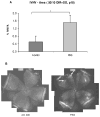The role of supplemental oxygen and JAK/STAT signaling in intravitreous neovascularization in a ROP rat model
- PMID: 19264880
- PMCID: PMC3682836
- DOI: 10.1167/iovs.08-3256
The role of supplemental oxygen and JAK/STAT signaling in intravitreous neovascularization in a ROP rat model
Abstract
Purpose: To investigate whether oxygen stresses experienced in retinopathy of prematurity (ROP) trigger signaling through reactive oxygen species (ROS) and whether the Janus kinase-signal transducer and activator of transcription (JAK/STAT) pathway lead to intravitreous neovascularization (IVNV) in an oxygen-induced retinopathy (OIR) rat model.
Methods: Newborn rat pups exposed to repeated fluctuations in oxygen and rescued in supplemental oxygen (28% O(2), 50/10 OIR+SO) were treated with apocynin, an NADPH oxidase and ROS inhibitor (10 mg/kg/d), AG490, a JAK2 inhibitor (5 mg/kg/d), or phosphate-buffered saline. Intraperitoneal injections were given from postnatal day (P)12 to P17 (apocynin), or from P3 to P17 (AG490). Outcomes were intravitreous neovascularization and avascular/total retinal areas, vascular endothelial growth factor, phosphorylated JAK2, and phosphorylated STAT3.
Results: Apocynin significantly reduced phosphorylated STAT3 in 50/10 OIR+SO (P = 0.04), in association with previously reported inhibition of the IVNV area. Inhibition of JAK with AG490 significantly reduced phosphorylated JAK2 (P < 0.001), phosphorylated STAT3 (P = 0.002), and IVNV area (P = 0.033) in the 50/10 OIR+SO model compared with control.
Conclusions: Activation of NADPH oxidase from supplemental oxygen works through activated STAT3 to lead to IVNV. In addition, inhibition of the JAK/STAT pathway reduces IVNV. Further studies are needed to determine the effects and relationships of oxygen stresses on JAK/STAT and NAPDH oxidase signaling.
Figures






Similar articles
-
Endothelial NADPH oxidase 4 mediates vascular endothelial growth factor receptor 2-induced intravitreal neovascularization in a rat model of retinopathy of prematurity.Mol Vis. 2014 Mar 3;20:231-41. eCollection 2014. Mol Vis. 2014. PMID: 24623966 Free PMC article.
-
Activated NAD(P)H oxidase from supplemental oxygen induces neovascularization independent of VEGF in retinopathy of prematurity model.Invest Ophthalmol Vis Sci. 2008 Apr;49(4):1591-8. doi: 10.1167/iovs.07-1356. Invest Ophthalmol Vis Sci. 2008. PMID: 18385079 Free PMC article.
-
Inhibition of NAD(P)H oxidase reduces apoptosis and avascular retina in an animal model of retinopathy of prematurity.Mol Vis. 2007 Jun 12;13:840-53. Mol Vis. 2007. PMID: 17615545 Free PMC article.
-
The effects of oxygen stresses on the development of features of severe retinopathy of prematurity: knowledge from the 50/10 OIR model.Doc Ophthalmol. 2010 Feb;120(1):25-39. doi: 10.1007/s10633-009-9181-x. Epub 2009 Jul 29. Doc Ophthalmol. 2010. PMID: 19639355 Free PMC article. Review.
-
Studies on the pathogenesis of avascular retina and neovascularization into the vitreous in peripheral severe retinopathy of prematurity (an american ophthalmological society thesis).Trans Am Ophthalmol Soc. 2010 Dec;108:96-119. Trans Am Ophthalmol Soc. 2010. PMID: 21212851 Free PMC article. Review.
Cited by
-
Microarray Analysis of Long Non-Coding RNAs and Messenger RNAs in a Mouse Model of Oxygen-Induced Retinopathy.Int J Med Sci. 2019 Apr 20;16(4):537-547. doi: 10.7150/ijms.31274. eCollection 2019. Int J Med Sci. 2019. PMID: 31171905 Free PMC article.
-
Discovering Mechanisms in the Changing and Diverse Pathology of Retinopathy of Prematurity: The Weisenfeld Award Lecture.Invest Ophthalmol Vis Sci. 2019 Apr 1;60(5):1286-1297. doi: 10.1167/iovs.18-25525. Invest Ophthalmol Vis Sci. 2019. PMID: 30933256 Free PMC article. No abstract available.
-
Effect of intravitreal and intraperitoneal cyanidin-3-glucoside injection in oxygen-induced retinopathy mouse model.Indian J Ophthalmol. 2019 Jun;67(6):801-805. doi: 10.4103/ijo.IJO_166_18. Indian J Ophthalmol. 2019. PMID: 31124490 Free PMC article.
-
Endothelial NADPH oxidase 4 mediates vascular endothelial growth factor receptor 2-induced intravitreal neovascularization in a rat model of retinopathy of prematurity.Mol Vis. 2014 Mar 3;20:231-41. eCollection 2014. Mol Vis. 2014. PMID: 24623966 Free PMC article.
-
Roles of Nicotinamide Adenine Dinucleotide Phosphate (NADPH) Oxidase in Angiogenesis: Isoform-Specific Effects.Antioxidants (Basel). 2017 Jun 3;6(2):40. doi: 10.3390/antiox6020040. Antioxidants (Basel). 2017. PMID: 28587189 Free PMC article. Review.
References
-
- Terry TL. Extreme prematurity and fibroblastic overgrowth of persistent vascular sheath behind each crystalline lens:(1) Preliminary report. Am J Ophthalmol. 1942;25:203–204. - PubMed
-
- Patz A, Eastham A, Higginbotham DH, Kleh T. Oxygen studies in retrolental fibroplasia. Am J Ophthalmol. 1953;36:1511–1522. - PubMed
-
- Cunningham S, Fleck BW, Elton RA, Mclntosh N. Transcutaneous oxygen levels in retinopathy of prematurity. Lancet. 1995;346:1464–1465. - PubMed
-
- McColm JR, Cunningham S, Wade J, et al. Hypoxic oxygen fluctuations produce less severe retinopathy than hyperoxic fluctuations in a rat model of retinopathy of prematurity. Pediatr Res. 2004;55:107–113. - PubMed
Publication types
MeSH terms
Substances
Grants and funding
LinkOut - more resources
Full Text Sources
Other Literature Sources
Miscellaneous

